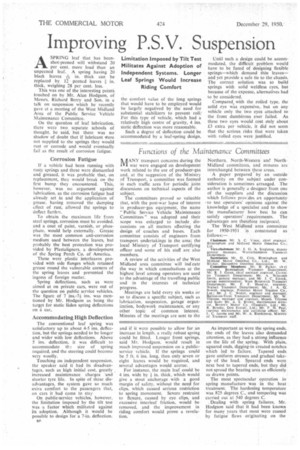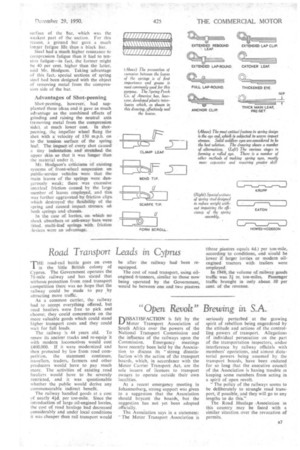Improving P.S.V. Suspension
Page 40

Page 41

If you've noticed an error in this article please click here to report it so we can fix it.
Limitation imposed by Tilt Test Militates Against Adoption of Independent Systems. Longer Leaf Springs Would Increase Riding Comfort
ASPRING leaf that has beenshot-peened will withstand 20 per cent, more load than an unpeened leaf. A spring having 20 black leaves * in. thick can be replaced by 12 • peened leaves ;„' in. thick, weighing 28 per cent. less.
This was one of the interesting points touched on by Mr. Alan Hodgson, of Messrs. Richard Berry and Son, in a talk on suspension which he recently gave at a meeting of the West Midland Area of the Public Service Vehicle Maintenance Committee.
On the question of leaf lubrication, there were two separate schools of thought, he said, but there was no shadow of doubt that if lubricant Were not supplied to the springs they would rust or corrode and would eventually fait as the result of corrosion fatigue.
Corrosion Fatigue If a vehicle had been running with rusty springs and these were dismantled and greased, it was probable that, on replacement, they would break on the first bump they encountered. This, however, was no argument against lubrication, as the corrosion fatigue had already set in and the application of grease, having removed the damping effect of rust, allowed the springs to deflect fa rth ..i.
To obtain the maximum life from steel springs, corrosion must be avoided. and a coat of paint, varnish, or phosphate, would help externally. Grease was the most common anti-corrosion ' medium used between the leaves, but probably the best protection was provided by Plastaligners, a development of the Spring Perch Co. of America.
These were plastic interleaves provided with side flanges which retained grease round the vulnerable corners of the spring leaves and prevented the ingress of foreign matter.
Spring deflections, such as were aimed at on private cars, were out of the question on public service vehicles. The figure of 7 ins.-74 ins, was mentioned by Mr. Hodgson as being the target for static laden spring deflections on i car.
Accommodating High Deflection
The conventional leaf spring was satisfactory up to about 4-5 ins, deflection, but the springs needed to be longer and wider with low deflections. Above 5 ins, deflection, it was difficult to accommodate th: size of spring required, and the steering could become very woolly.
Touching on independent suspension, the speaker said it had its disadvantages, such as high initial cost, greatly . increased maintenance charges and shorter tyre life. In spite of these disadvantages, the system gave so much extra comfort to the passengers that, on cars it had come to stay
On public-service vehicles, however, the !imitation imposed by the tilt test was a factor which militated against its adoption. Although it would be possible to design for a 7-in, deflection.
n6 the comfort value of the long springs that would have to be employed would be largely negatived by the need for substantial stabilizers to prevent roll. For this type of vehicle, which had a relatively high centre of gravity, 4 ins. static deflection was more reasonable.
Such a degree of deflection could be accommodated by a leaf-spring design,
and if it were possible to allow for an increase in length. a really robust spring could be fitted. Longer front springs, said Mr. Hodgson, would result in much improved suspension on a publicservice vehicle. If the springs could be 5 ft. 6 ins, long, then only seven or eight leaves would be required, and several advantages would accrue.
For instance, the main leaf could be 4 ins, wide by 4 in. thick, which would give a stout anchorage with a good margin of safety, without the need for clips, which caused serious restriction to spring movement. Severe restraint to flexure, caused by eye clips, and excessive interleaf friction, would be removed, and the improvement in riding comfort would prove a revelation. Until such a design could be accommodated, the difficult problem would have to be faced of designing flexible springs—which demand thin leaves— and yet provide a safe tie to the chassis. The correct solution was to build springs with solid weldless eyes, but because of the expense, alternatives had to be considered.
Compared, with the rolled type, the solid eye was expensive, but on any vehicle only the two eyes attached to the front clumbirons ever failed. As these two eyes would cost only about £3 extra per vehicle, it did not seem that the serious risks that were taken with rolled eyes were justified.
As important as were the spring ends, the ends of the 'leaves also demanded attention, as they had a strong influence on the life of the spring. With plain, squared ends, digging-in created notches which led to failure. Tapered ends gave uniform stresses and gradual takeup of the load. Speared ends were next hest to tapered ends, but they did not spread the bearing area as efficiently as drawn points.
The most spectacular operation in spring manufacture was in the heat treatment. The hardening temperature was 825 degrees C., and tempering was carried out at 540 degrees C.
Dealing with spring failures. Mr. Hodgson said that it had been known for many years that most were caused by fatigue flaws originating on the surface of the bar, which was the weakest part of the section. For this reason, a ground bar gave a much longer fatigue life than a black bar.
Steel had a much higher resistance to compression fatigue than it had to tension fatigue----in fact, the former might be 40 per cent, higher than the latter, said Mr. Hodgson. Taking advantage of this fact; special sections of spring steel had been designed with the object of removing metal from the compression side of the bar.
Advantages of Shot-peening
Shot-peening, however, had supplanted these ideas and. it gave as much advantage as the combined effects of grinding and raising the neutral axis (removing metal from the compression side). at much lower cost. In shotpeening, the impellor wheel flung the shot with a velocity of 150 m.p.h. on to the tension surface of the spring leaf. The impact of every shot caused a tiny indentation and stretched the upper skin, so that it was longer than he material under it.
Mr. Hodgson's criticisms of existing systems of front-wheel suspension on public-service vehicles were that. the main leaves of the springs were dangerously weak; there was excessive interleaf friction caused by the large number of leaves employed, and this was further aggravated by friction clips which destroyed the flexibility of the spring and caused impact stresses oh both springs and chassis. In the case of lorries, on which no shock absorbers or anti-sway bars were fitted. multi-leaf springs with friction devices were an advantage:




















































































